If you’re struggling to develop strong, defined shoulders, odds are you’re doing the wrong shoulder exercises.
Don’t worry—I’m here to help.
In this article, you’ll learn the best shoulder exercises for men and women and tips on how to include these exercises for shoulders in your workouts.
Table of Contents
+
The 15 Best Shoulder Exercises
1. Standing Overhead Press
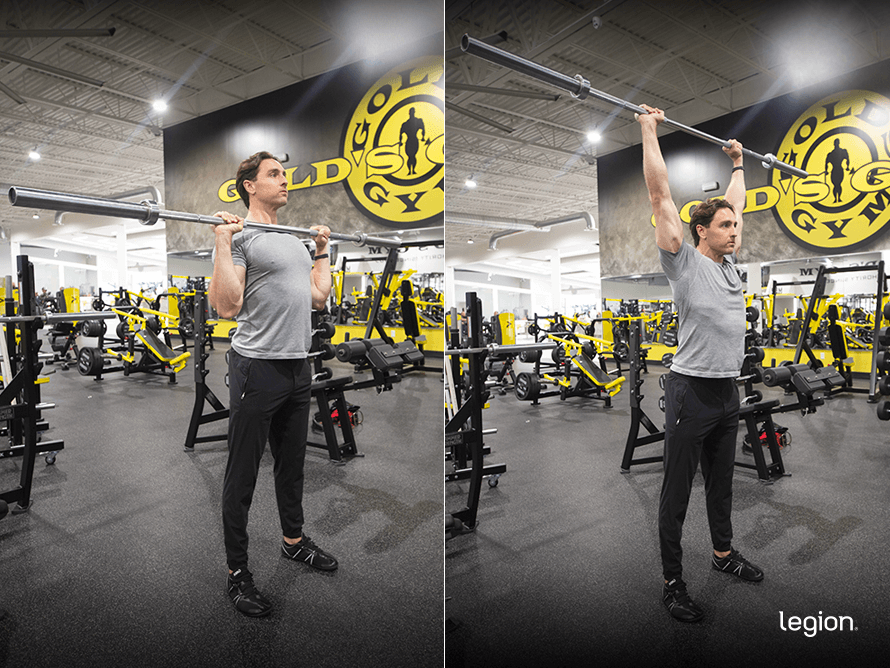
The standing overhead press trains all your shoulder muscles to a high degree. It also allows you to lift heavy weights safely and progress regularly, making it one of the best shoulder-strengthening exercises.
How to:
- Set a barbell in a rack at the same height as your upper chest.
- Grip the bar with a shoulder-width grip and your palms facing away from you.
- Unrack the barbell, step backward, and plant your feet just outside of shoulder width.
- Push the bar toward the ceiling until your arms are straight.
- Reverse the movement and return to the starting position.
Sets and Reps: 3 sets of 4-to-6 reps with 2-to-3 min rest
2. Push Press
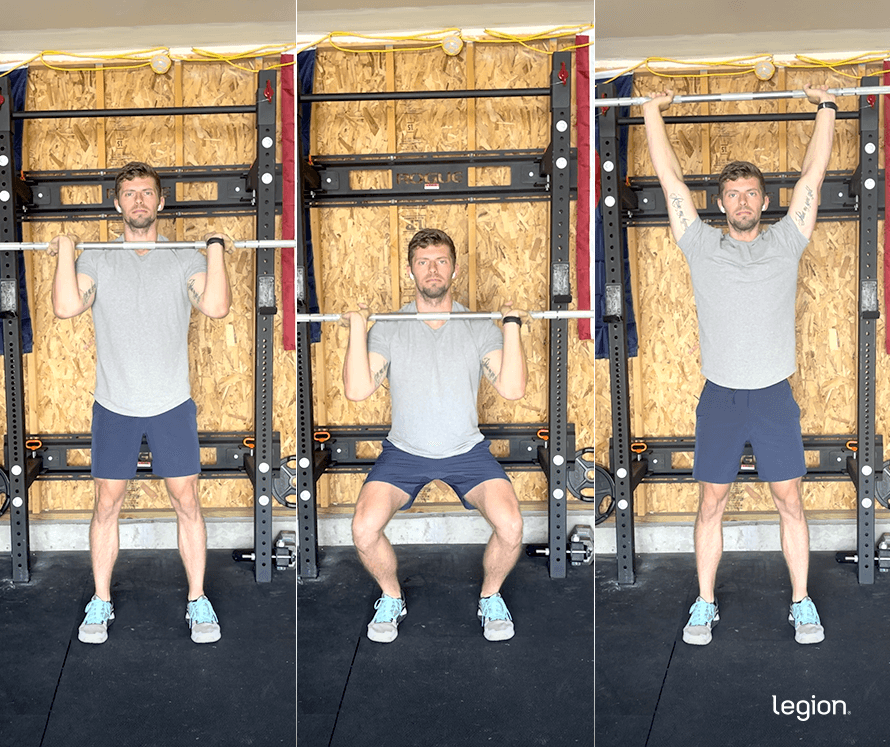
The push press is a variation of the standing overhead press that uses momentum generated by your lower body to help you press heavier weights overhead. It’s an excellent exercise for developing shoulder power, making it particularly beneficial for athletes.
How to:
- Set a barbell in a rack at the same height as your upper chest.
- Grip the bar with a shoulder-width grip and your palms facing away from you.
- Unrack the barbell, step backward, and plant your feet just outside of shoulder width.
- Drop your butt 3-to-6 inches by bending your knees, then shoot your hips upward and explosively straighten your knees.
- Press the bar straight up using the momentum generated by your lower body.
- Reverse the movement and return to the starting position.
Sets and Reps: 3 sets of 4-to-6 reps with 2-to-3 min rest
3. Seated Overhead Press
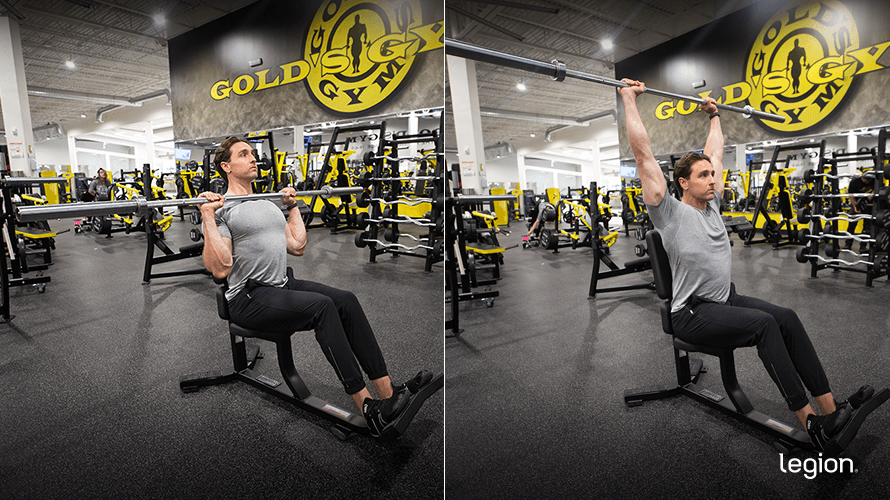
The seated overhead press allows you to lift heavier weights and progress faster than most other shoulder exercises, making it an ideal addition to your shoulder training.
How to:
- Set up an upright bench in a squat rack or use a seated barbell overhead press station.
- Set a barbell in the rack at about shoulder height when standing.
- Sit down and grip the bar with a shoulder-width grip and your palms facing away from you.
- Unrack the barbell and lower it to your collarbone.
- Press the bar toward the ceiling and return to the starting position.
Sets and Reps: 3 sets of 4-to-6 reps with 2-to-3 min rest
4. Shoulder Press
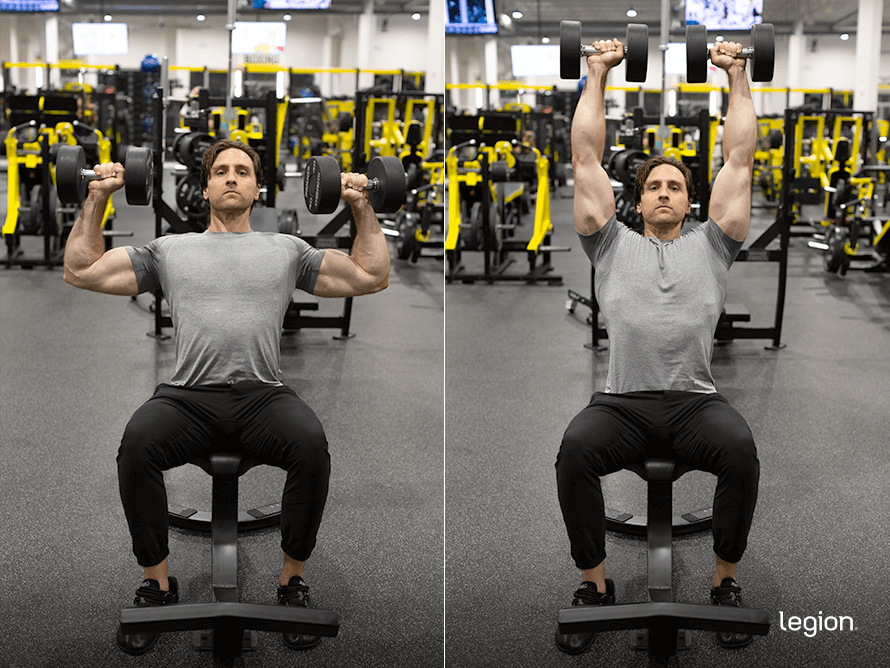
Because the shoulder press involves lifting dumbbells, it’s helpful for finding and fixing muscle and strength imbalances. It also trains your shoulders through a longer range of motion than barbell overhead pressing exercises, which is generally beneficial for muscle growth.
How to:
- Sit on an upright bench and hold a dumbbell in each hand, resting them on your thighs.
- Hoist the dumbbells up so you’re holding them just above your shoulders with your palms facing away from you.
- Press the dumbbells toward the ceiling until your arms are straight.
- Lower the dumbbells and return to the starting position.
Sets and Reps: 3 sets of 4-to-6 reps with 2-to-3 min rest
5. Arnold Press
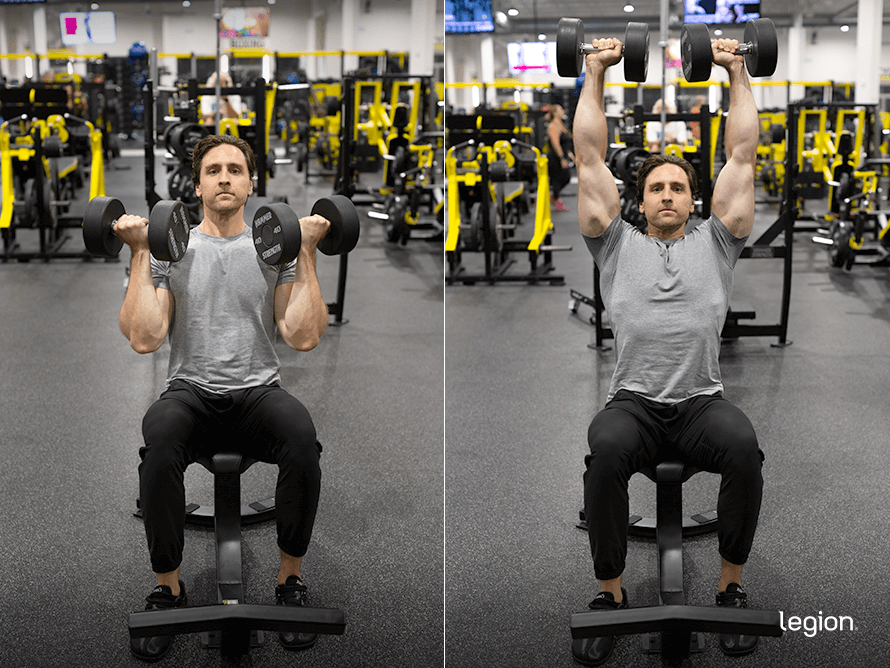
The Arnold press emphasizes your side delts more than other overhead pressing variations, making it an excellent exercise for balanced shoulder development.
How to:
- Sit on an upright bench and hold a dumbbell in each hand, resting them on your thighs.
- Hoist the dumbbells up so you’re holding them just in front of your shoulders with your palms facing you.
- Press the dumbbells straight overhead while rotating your wrists until your arms are straight and your palms are facing away from you.
- Reverse the movement and return to the starting position.
Sets and Reps: 3 sets of 4-to-6 reps with 2-to-3 min rest
6. Machine Shoulder Press
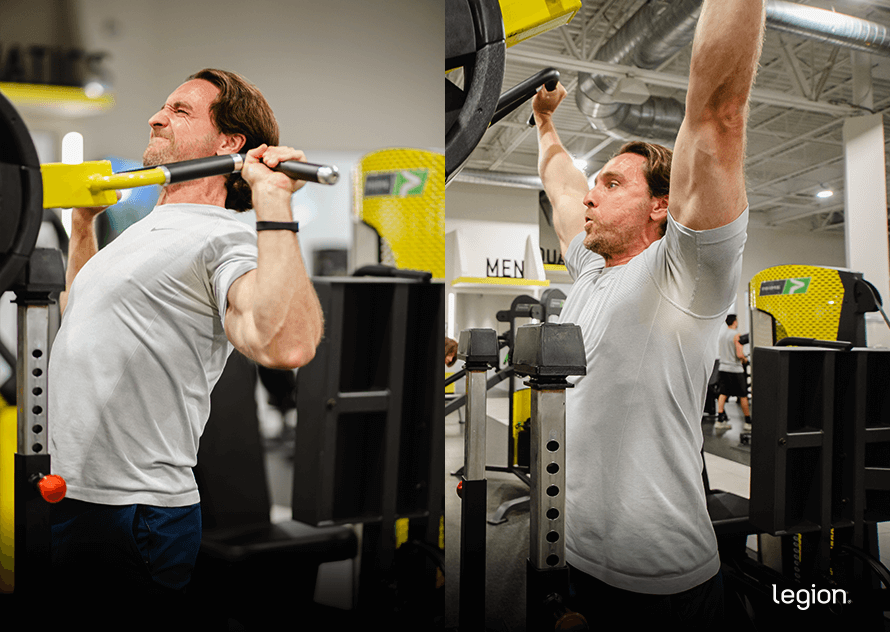
The machine shoulder press is a good option for training your deltoid muscles if you’re new to weightlifting, working around an injury, don’t have access to a barbell or dumbbells, or want to change up your training.
How to:
- Adjust the shoulder press machine’s seat so the handles are about the same height as your ears, then sit down.
- Grip the handles with your palms facing away from you, then press them toward the ceiling until your arms are straight.
- Reverse the movement and return to the starting position.
Sets and Reps: 3 sets of 8-to-10 reps with 2-to-3 min rest
7. Handstand Push-up
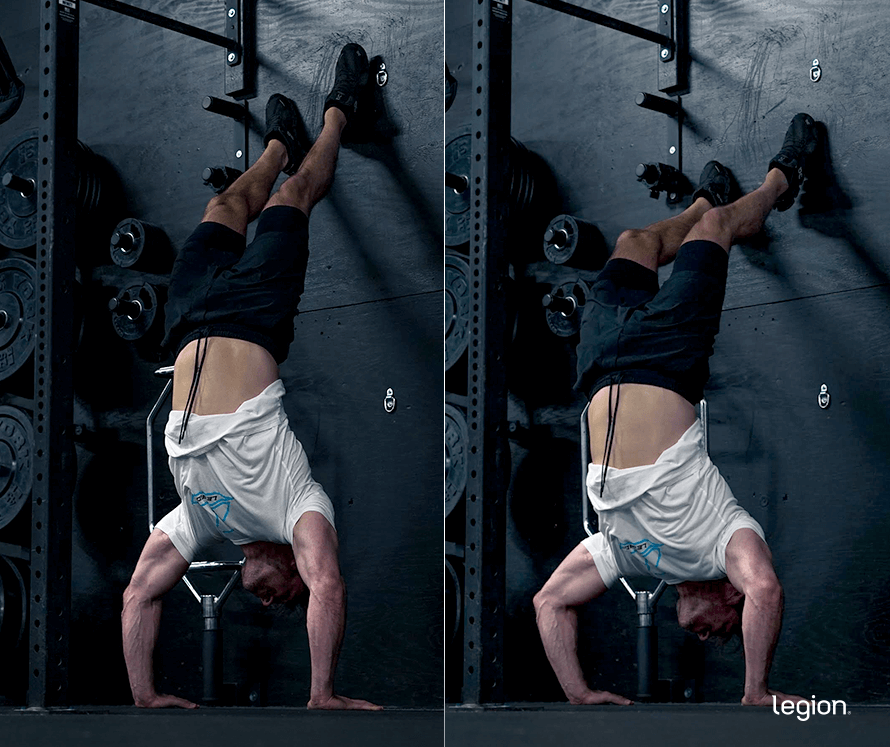
The handstand push-up primarily trains your shoulders, triceps, and upper back. However, it also requires exceptional balance and coordination, which means it trains stabilizer muscles throughout your body, too.
How to:
- While facing a wall, bend down and place your palms on the floor 6-to-12 inches from the wall with your middle fingers pointing forward.
- Without moving your hands, jump into a handstand, resting your heels against the wall.
- Bend your elbows and lower your head toward the floor.
- When your head taps the floor, push through your hands and return to the starting position.
Sets and Reps: 3 sets of 8-to-10 reps with 2-to-3 min rest
8. Resistance Band Push-up
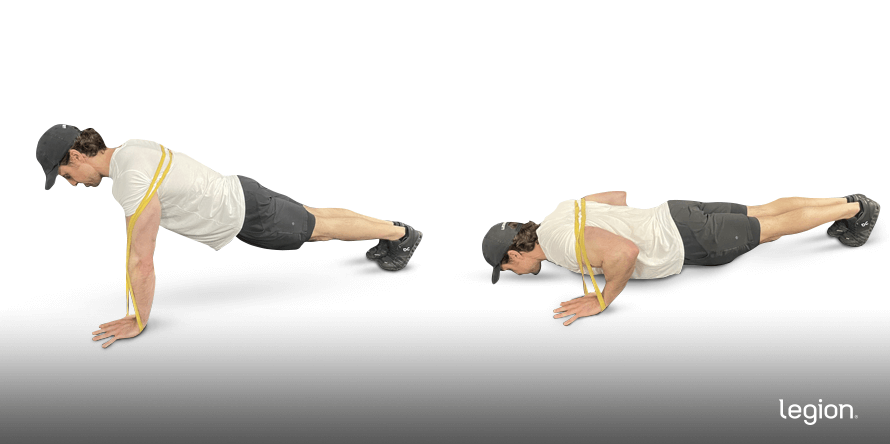
The push-up is an excellent exercise for training all your upper-body pushing muscles, including your shoulders. Adding a resistance band makes the exercise significantly more challenging, making it more effective for gaining muscle and strength.
- While holding one end of an exercise band in each hand, wrap the band around your back, just under your armpits.
- Get on all fours and place your hands slightly wider than shoulder-width apart.
- Extend your legs behind you so that your hands and toes support your weight and your body forms a straight line from your head to your feet.
- Lower your chest to the floor, then push your body up and return to the starting position.
Sets and Reps: 3 sets of 10-to-20 reps with 1-to-2 min rest
9. Dumbbell Front Raise
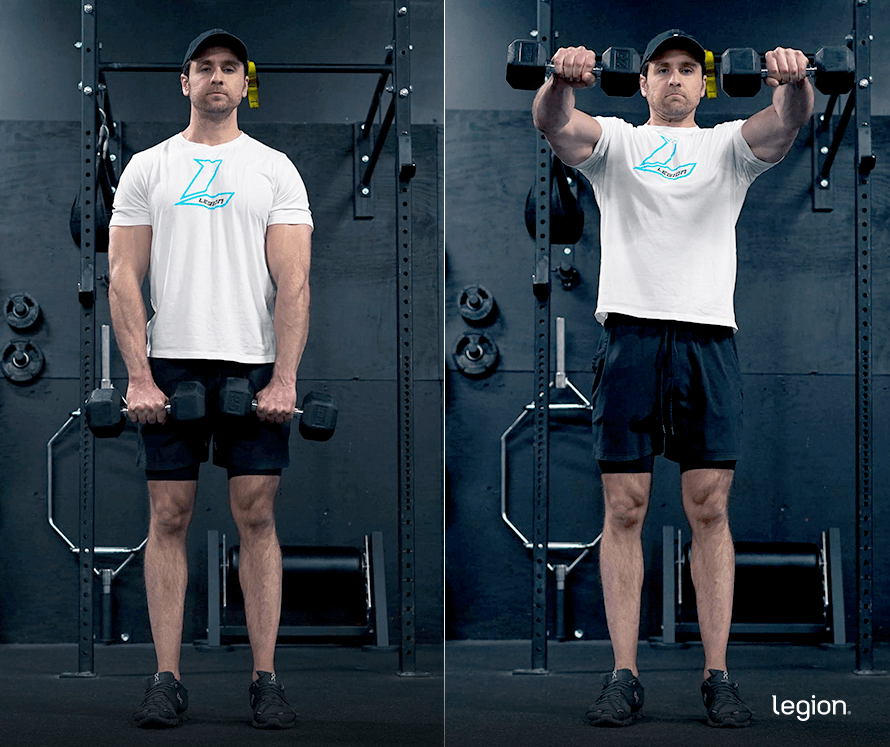
The dumbbell front raise isolates your front delts. While these muscles get plenty of stimulation during pushing exercises, the dumbbell front raise can be useful if you’re working around an injury and can’t perform presses.
How to:
- Stand up straight with a dumbbell in each hand.
- Raise the dumbbells out in front. Continue raising your arms until your upper arm is parallel to the floor.
- Reverse the movement and return to the starting position.
Sets and Reps: 3 sets of 6-to-8 reps with 2-to-3 min rest
10. Dumbbell Side Lateral Raise
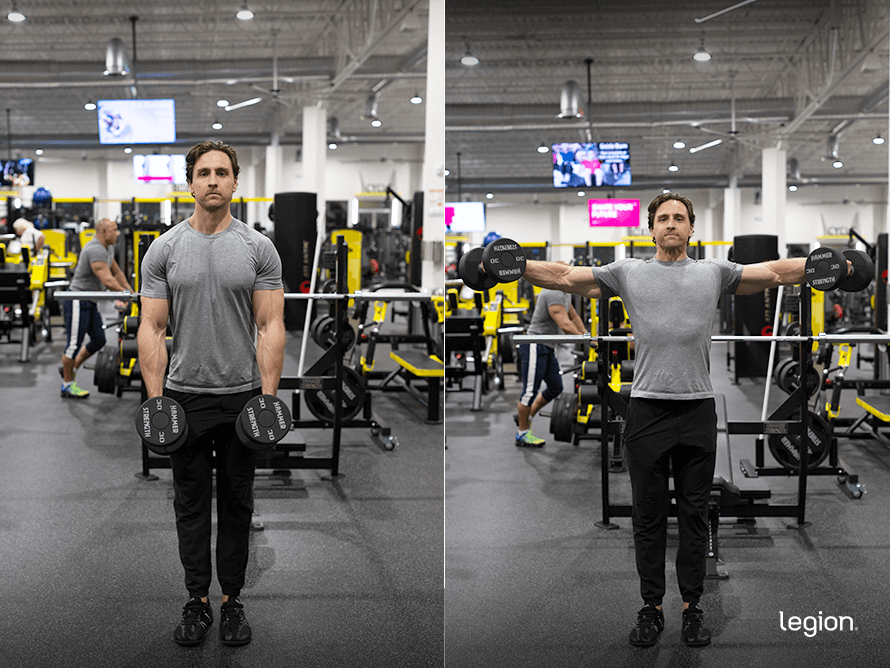
The dumbbell side lateral raise is one of the best exercises for isolating the side delts. While it’s effective for everyone, the dumbbell side lateral raise is a particularly popular shoulder exercise for women since it helps develop the “defined” shoulder look many women like.
How to:
- Stand up straight with a dumbbell in each hand.
- Raise the dumbbells out to your sides until your upper arm is parallel to the floor.
- Reverse the movement and return to the starting position.
Sets and Reps: 3 sets of 6-to-8 reps with 2-to-3 min rest
11. Cable Side Lateral Raise

The cable and dumbbell side lateral raises train the same muscles to a comparable degree, so you can think of them as interchangeable. Again, the cable lateral raise is a good shoulder exercise for women because it helps make your shoulder look more defined, which many women want.
How to:
- Set the pulley on a cable machine to the lowest setting and attach a single handle attachment.
- Stand with your feet either touching or shoulder-width apart, parallel to the handle, and your right foot closer to the handle than your left.
- Grab the handle with your left hand and the machine with your right hand (most people prefer to grab the metal column that holds the pulleys), then lean your body to the left until your right arm fully extends.
- Raise your left hand out to the side until your upper arm is parallel to the floor.
- Reverse the movement and return to the starting position.
- Once you’ve completed the desired number of reps, switch sides and repeat the process with your right arm.
Sets and Reps: 3 sets of 6-to-8 reps with 2-to-3 min rest
12. Upright Row
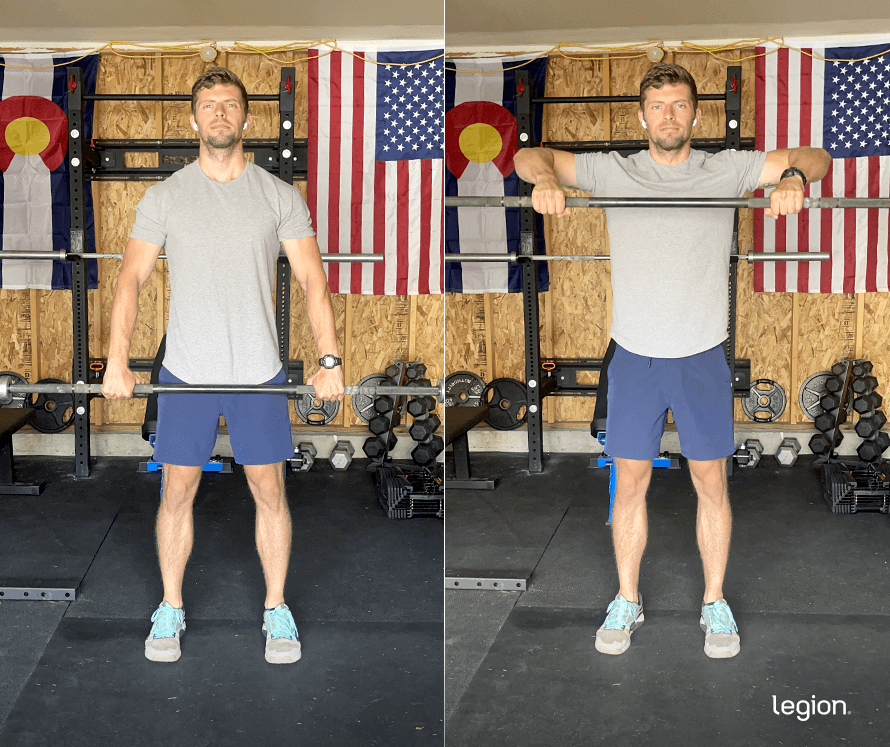
The upright row trains your side delts similarly to the side lateral raise, making it an excellent exercise for rounding out shoulder development. That said, some people find the upright row unkind on their rotator cuff muscles and shoulder joints. To avoid this, simply raise the weight until your upper arm is parallel to the floor and no further.
How to:
- Stand up straight and hold a barbell in front of your thighs with your palms facing you.
- Lift the bar straight upward until your upper arms are parallel with the floor, keeping your elbows higher than your forearms throughout the movement.
- Reverse the movement and return to the starting position.
Sets and Reps: 3 sets of 6-to-8 reps with 2-to-3 min rest
13. Dumbbell Rear Lateral Raise
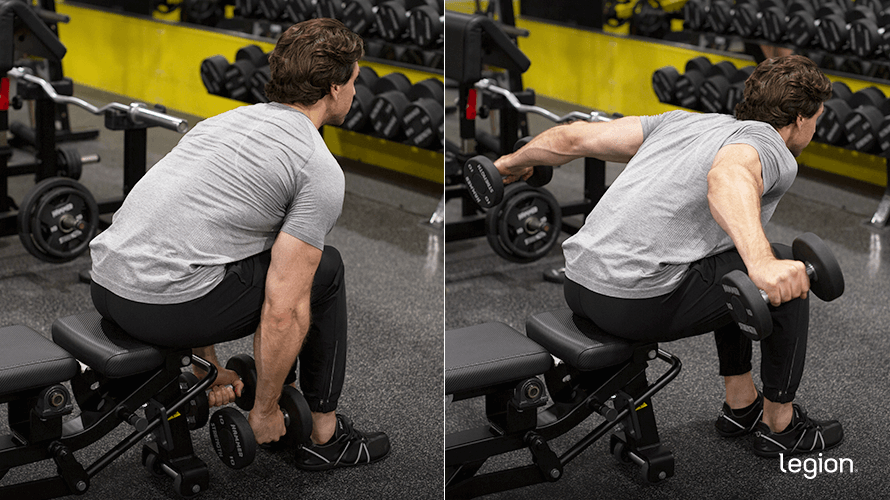
As well as being one of the best dumbbell exercises for training your posterior deltoids, the dumbbell rear lateral raise effectively trains the traps and rhomboids.
How to:
- Whether standing or seated, bend at the hips so that your upper body is as close to parallel to the floor as possible.
- Hold a dumbbell in each hand, and while keeping your back flat, lift the dumbbells out to the side until your upper arm is parallel to the floor. As you lift the dumbbells, squeeze your shoulder blades together.
- Reverse the movement and return to the starting position.
Sets and Reps: 3 sets of 6-to-8 reps with 2-to-3 min rest
14. Machine Reverse Fly
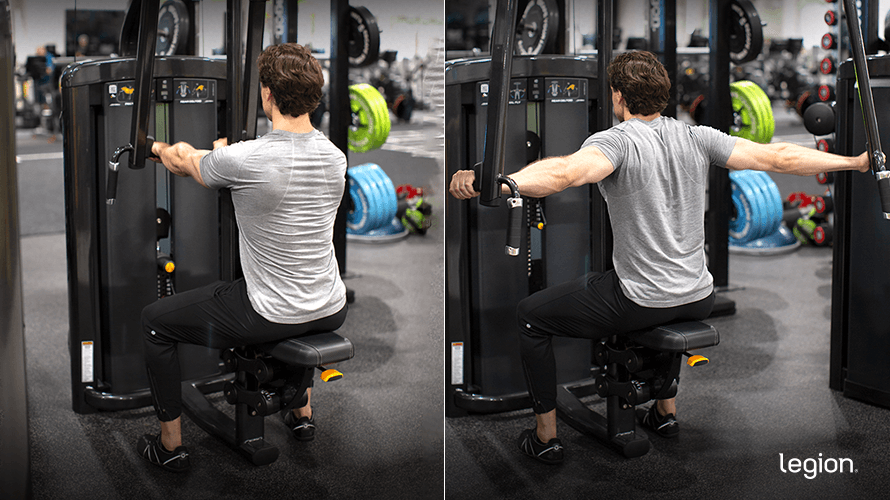
The machine reverse fly trains your posterior deltoids to a high degree, making it a fantastic exercise for developing the backs of your shoulders.
How to:
- Sit down with your body facing the machine and grab the handles with your palms facing down.
- While maintaining a slight bend in your elbows, move the weight back in an arc until your arms are directly out to your sides (or slightly behind your body). As you lift the weight, squeeze your shoulder blades together.
- Reverse the movement and return to the starting position.
Sets and Reps: 3 sets of 8-to-10 reps with 2-to-3 min rest
15. Barbell Rear Delt Row
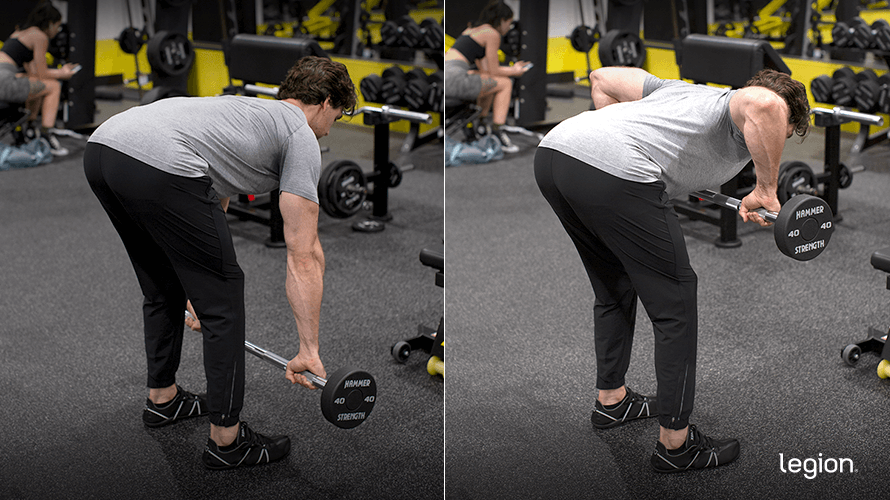
The barbell rear delt row trains your posterior deltoids similarly to the dumbbell rear lateral raise. As such, you can use them interchangeably in your shoulders workouts.
How to:
- Position your feet about shoulder-width apart with your toes pointed slightly outward.
- Grab a barbell with a slightly wider than shoulder-width grip and your palms facing you.
- Flatten your back so it’s roughly parallel to the floor, and let your arms hang straight down.
- Pull the barbell to your mid-chest, flaring your elbows at about a 60-degree angle relative to your body. As you lift the weight, squeeze your shoulder blades together.
- Reverse the movement and return to the starting position.
Sets and Reps: 3 sets of 6-to-8 reps with 2-to-3 min rest
Shoulder Anatomy
The deltoid muscles—or “delts”—are the muscles that cover your shoulder joints and help your upper arms move forward, upward, and backward.
Each deltoid has three sections or “heads:” the anterior deltoid (“front delt”), the lateral deltoid (“side delt”), and the posterior deltoid (“rear delt”).
Here’s how they look on your body:
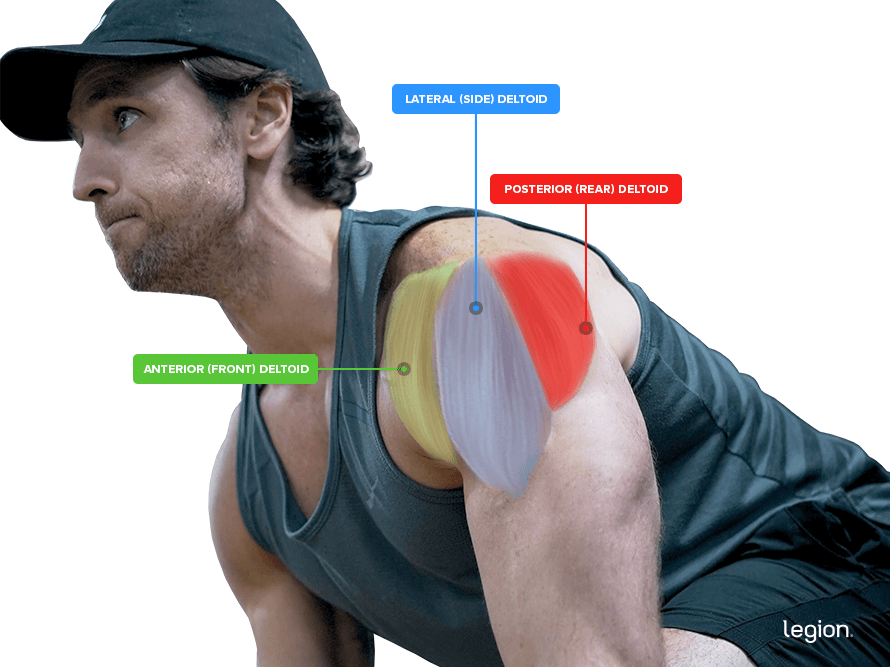
Underneath the deltoids is a complex group of muscles and tendons called the rotator cuff.
This small but important muscle group works alongside the deltoids to stabilize your shoulder joint and give the shoulder its impressive range of motion.
The rotator cuff comprises the following four muscles and their tendons:
- Supraspinatus
- Infraspinatus
- Teres minor
- Subscapularis
Shoulder Training Tips
1. Train your shoulders with 10-to-20 weekly sets.
To optimize their development, train your shoulders with 10-to-20 weekly sets.
Those who’ve followed a strength training program for under 2 years should target 10-to-15 weekly sets. In contrast, those with over 2 years of training experience should strive for 15-to-20 weekly sets.
Completing 10-to-15 sets in one session should be challenging but doable.
However, if you’re aiming for more than 15 weekly sets, trying to do them in one workout is impractical. Instead, spread your sets across 2-to-3 weekly workouts.
2. Train each head of the deltoids.
To ensure proportional development, train each head of your deltoids with equal volume (sets).
In other words, allocate a third of your shoulder training to your front delts, another third to your side delts, and the remainder to your rear delts.
To make organizing your training easier, here are the best exercises for training each head:
- Front delt: Standing overhead press, push press, seated overhead press, shoulder press, Arnold press, machine shoulder press, handstand push-up, resistance band push-up, and front raise.
- Side delt: Dumbbell side lateral raise, cable side lateral raise, and upright row.
- Rear delt: Dumbbell rear lateral raise, machine reverse fly, and barbell rear delt row.
Or if you’d like a program designed to help you build proportional shoulders, check out my fitness books for men and women, Bigger Leaner Stronger or Thinner Leaner Stronger.
3. End every set 1-to-2 reps shy of muscle failure.
To maximize muscle and strength gains, you need to take most of your sets within a rep or two of muscle failure—the point at which you can’t complete a rep despite giving maximum effort.
Ask yourself at the end of each set, “If I absolutely had to, how many more reps could I have gotten with good form?” If the answer is more than two, increase the weight or reps to make your next set more challenging.
4. Once you hit the top of your rep range for one set, increase the weight.
For example, let’s say your shoulder workout calls for 4-to-6 reps of the overhead press. If you get 6 reps for a set, add 10 pounds (total) for your next set and work with that weight until you can (eventually) press it for 6 reps, and so forth.
If you get 3 or fewer reps with your new (higher) weight on your next sets, reduce the weight by 5 pounds to ensure you can stay within your target rep range (4-to-6) for all sets.
Follow this pattern of trying to add reps or weight to every exercise in every workout.
5. Take the right supplements.
The best supplements for maximizing shoulder development are:
- Protein powder: Taking protein powder is a convenient way to provide your body with the nutrients needed to build muscle tissue and recover from workouts. If you want a clean and delicious protein powder, try Whey+ or Casein+.
- Creatine: Creatine boosts muscle and strength gain, improves anaerobic endurance, and reduces muscle damage and soreness from your workouts. If you want a natural source of creatine that also includes two other ingredients to enhance muscle growth and improve recovery, try Recharge.
- Pre-workout: A quality pre-workout helps you train harder by enhancing energy, mood, and focus, increasing strength and endurance, and reducing fatigue. If you want a natural pre-workout containing clinically effective doses of 6 science-backed ingredients, try Pulse with caffeine or without.
(If you’d like even more specific advice about which supplements you should take to reach your health and fitness goals, take the Legion Supplement Finder Quiz, and in less than a minute, you’ll know exactly what supplements are right for you. Click here to check it out.)
Scientific References +
- https://www.researchgate.net/publication/322132613_Comparison_among_the_EMG_Activity_of_the_Anterior_Deltoid_and_Medial_Deltoid_During_Two_Variations_of_Dumbbell_Shoulder_Press_Exercise
- Calatayud, Joaquin, et al. “Bench Press and Push-up at Comparable Levels of Muscle Activity Results in Similar Strength Gains.” Journal of Strength and Conditioning Research, vol. 29, no. 1, Jan. 2015, pp. 246–253, https://doi.org/10.1519/jsc.0000000000000589. Accessed 30 Aug. 2020.
- Kikuchi, Naoki, and Koichi Nakazato. “Low-Load Bench Press and Push-up Induce Similar Muscle Hypertrophy and Strength Gain.” Journal of Exercise Science & Fitness, vol. 15, no. 1, June 2017, pp. 37–42, https://doi.org/10.1016/j.jesf.2017.06.003. Accessed 24 Apr. 2019.
- Coratella, Giuseppe, et al. “An Electromyographic Analysis of Lateral Raise Variations and Frontal Raise in Competitive Bodybuilders.” International Journal of Environmental Research and Public Health, vol. 17, no. 17, 19 Aug. 2020, p. 6015, https://doi.org/10.3390/ijerph17176015. Accessed 23 Nov. 2020.
- Campos, Yuri A. C., et al. “Different Shoulder Exercises Affect the Activation of Deltoid Portions in Resistance-Trained Individuals.” Journal of Human Kinetics, vol. 75, no. 1, 31 Oct. 2020, pp. 5–14, https://doi.org/10.2478/hukin-2020-0033.
- Sweeney, Kevin D. , et al. “Impact of Shippers’ Choice on Transportation System Congestion and Performance”: Transportation Journal, vol. 53, no. 2, 2014, p. 143, https://doi.org/10.5325/transportationj.53.2.0143. Accessed 2 June 2020.
- Schoenfeld, Brad J , et al. The Upright Row: Implications for Preventing Subacromial Impingement. Oct. 2011, https://doi.org/10.1519/SSC.0b013e31822ec3e3.
- Franke, Rodrigo , et al. Analysis of Anterior, Middle and Posterior Deltoid Activation during Single and Multijoint Exercises. June 2014.
- Smita Maruvada, and Matthew Varacallo. “Anatomy, Rotator Cuff.” Nih.gov, StatPearls Publishing, 14 Nov. 2018, www.ncbi.nlm.nih.gov/books/NBK441844/.
- Stokes, Tanner, et al. “Recent Perspectives Regarding the Role of Dietary Protein for the Promotion of Muscle Hypertrophy with Resistance Exercise Training.” Nutrients, vol. 10, no. 2, 7 Feb. 2018, p. 180, www.mdpi.com/2072-6643/10/2/180/pdf, https://doi.org/10.3390/nu10020180.
- Jd, Branch. “Effect of Creatine Supplementation on Body Composition and Performance: A Meta-Analysis.” International Journal of Sport Nutrition and Exercise Metabolism, 1 June 2003, pubmed.ncbi.nlm.nih.gov/12945830/.
- Eckerson, Joan M., et al. “Effect of Creatine Phosphate Supplementation on Anaerobic Working Capacity and Body Weight after Two and Six Days of Loading in Men and Women.” The Journal of Strength and Conditioning Research, vol. 19, no. 4, 2005, p. 756, https://doi.org/10.1519/r-16924.1. Accessed 23 Aug. 2019.
- Bassit, Reinaldo Abunasser, et al. “Effect of Short-Term Creatine Supplementation on Markers of Skeletal Muscle Damage after Strenuous Contractile Activity.” European Journal of Applied Physiology, vol. 108, no. 5, 3 Dec. 2009, pp. 945–955, https://doi.org/10.1007/s00421-009-1305-1. Accessed 13 Nov. 2020.










